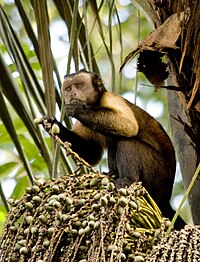Tufted capuchin
| Tufted capuchin | |
|---|---|
 |
|
| Brown tufted capuchin in French Guyana | |
| Scientific classification | |
| Kingdom: | Animalia |
| Phylum: | Chordata |
| Class: | Mammalia |
| Order: | Primates |
| Family: | Cebidae |
| Genus: | Sapajus |
| Species: | S. apella |
| Binomial name | |
|
Sapajus apella (Linnaeus, 1758) |
|
 |
|
| Geographic range following taxonomy used by IUCN | |
The tufted capuchin (Sapajus apella), also known as brown capuchin, black-capped capuchin, or pin monkey is a New World primate from South America. As traditionally defined, it is one of the most widespread primates in the Neotropics, but it has recently been recommended considering the black-striped, black and golden-bellied capuchins as separate species in a new genus, thereby effectively limiting the tufted capuchin to the Amazon basin and nearby regions.
The tufted capuchin is an omnivorous animal, mostly feeding on fruits and invertebrates, although it sometimes feeds on small vertebrates (e.g. lizards and bird chicks) and other plant parts. It can be found in many different kinds of environment, including moist tropical and subtropical forest, dry forest, and disturbed or secondary forest.
Like other capuchins, it is a social animal, forming groups of 8 to 15 individuals that are led by an alpha or dominant male.
At one point all tufted capuchins were classified as Cebus apella. Under such taxonomy, the range of C. apella would extend throughout much of South America from Colombia to northern Argentina. More recent taxonomic studies have been carried out by Torres de Assumpção (1983; Torres 1988). Groves (2005) recognized the following subspecies for the tufted capuchins:
In 2011, Jessica Lynch Alfaro et al proposed that the robust capuchins such (formerly the C. apella group) be placed in a separate genus, Sapajus, from the gracile capuchins (formerly the C. capucinus group) which retain the genus Cebus.
The tufted capuchin is more powerfully built than the other capuchins, with rougher fur and a long, thick tail. It has a bundle of long, hardened hair on the forehead that can be raised as a sort of "wig". The fur is brownish gray, with the belly being somewhat lighter-colored than the rest of the body. The hands and feet are black. The tail is prehensile: strong and can be used for grasping, as an extra limb.
...
Wikipedia

